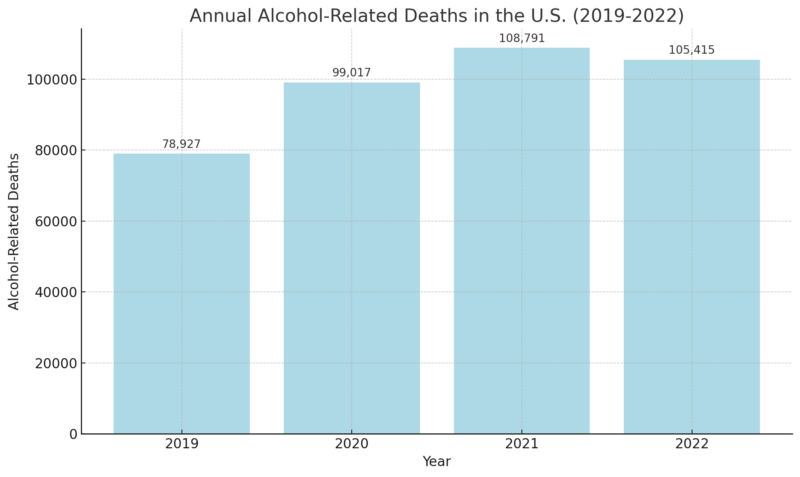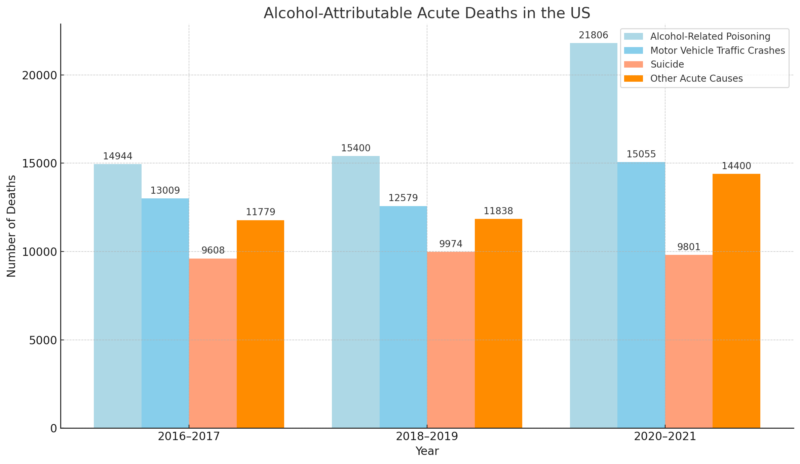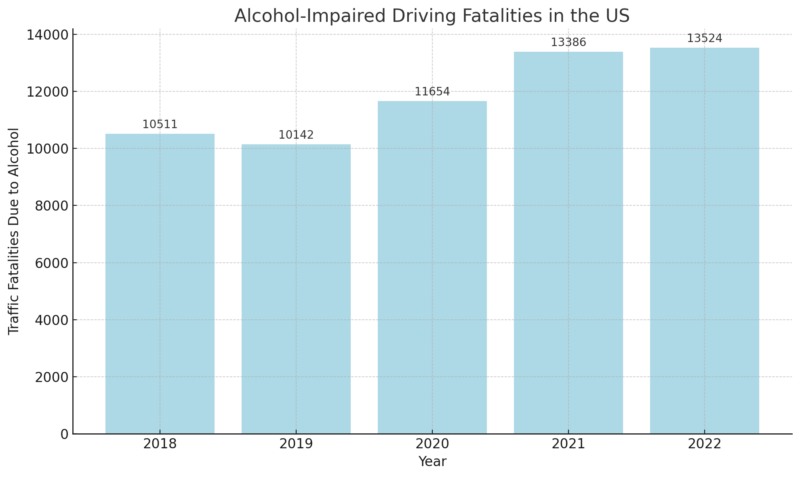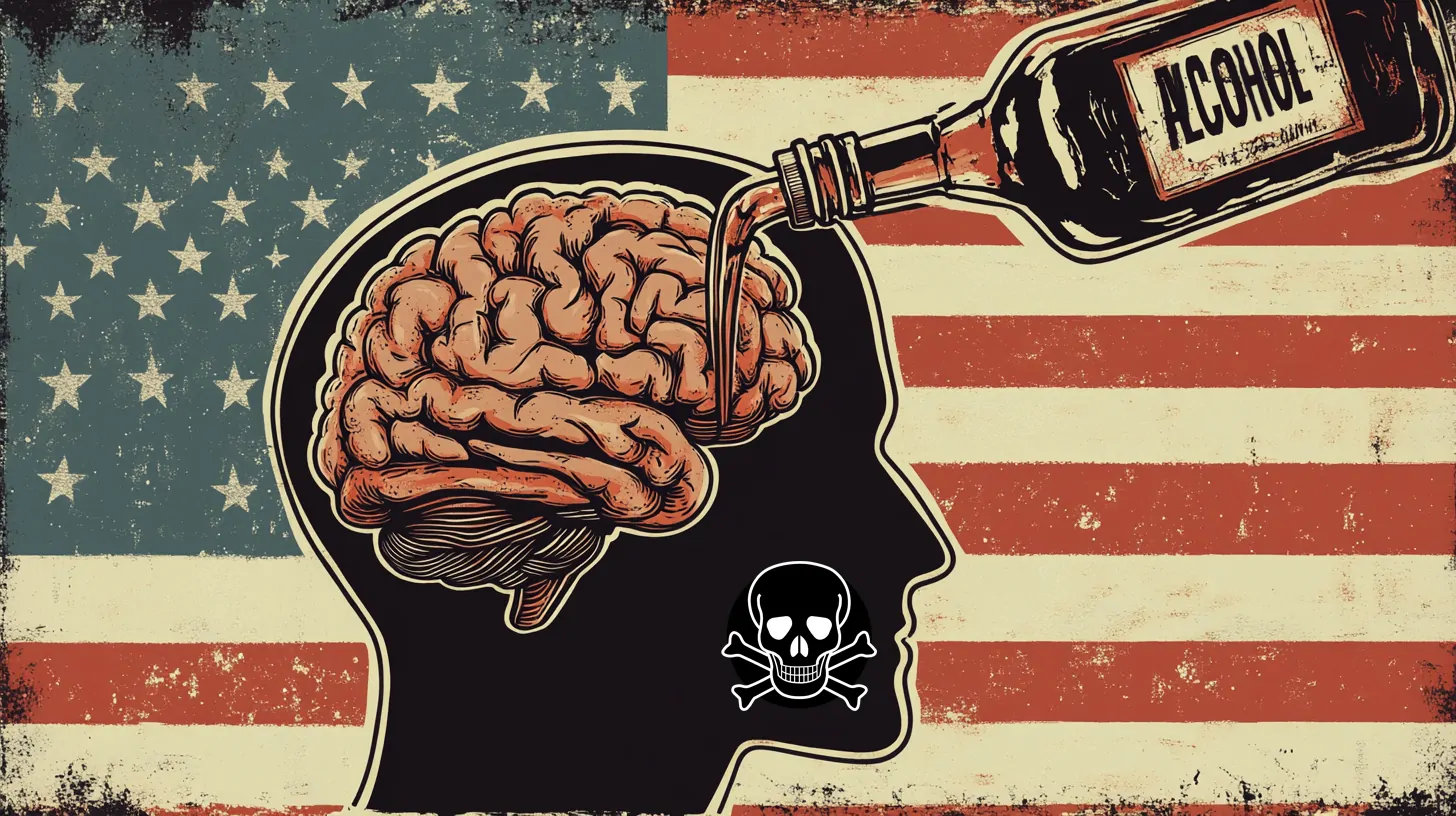Recent data paints a grim picture: the rate of alcohol-related emergency department visits increased by 47% between 2006 and 2014, equating to an additional 210,000 visits per year according to NIAAA.
Moreover, alcohol was implicated in 17.4% of opioid overdose deaths in 2020, emphasizing its role in the ongoing substance abuse crisis. In 2022 alone, 105,415 Americans died due to alcohol-related causes, highlighting the growing urgency of this public health crisis.
Table of Contents
ToggleKey Takeaways
The Rising Trend of Alcohol-Related Deaths in the U.S.
Alcohol-related deaths are on the rise in the U.S., with significant increases in liver disease & other conditions. Experts urge a shift in public discourse to address these alarming trends.https://t.co/jyQ1aWnQte
— MLMIC (@MLMIC) July 15, 2024
Alcohol-related deaths have surged in recent years, particularly during the COVID-19 pandemic. Stress, isolation, and increased alcohol availability led to an unprecedented spike in fatalities.
Shocking Statistics on Alcohol-Related Deaths
- In 2019, alcohol-related deaths stood at 78,927 as noted by the NIAAA.
- The first year of the COVID-19 pandemic (2020) saw a 25.5% increase, bringing the total to 99,017 deaths.
- The trend continued into 2021, with deaths rising another 9.9%, reaching 108,791.
- In 2022, deaths slightly declined to 105,415, but the toll remains alarmingly high.
The table below illustrates this concerning increase:
Annual Alcohol-Related Deaths in the U.S. (2019-2022)

This sharp rise in fatalities underscores the need for urgent policy intervention and public awareness campaigns to address excessive alcohol consumption.
Alcohol’s Role in Preventable Deaths

1. Chronic Conditions Linked to Alcohol
Excessive alcohol use contributes to several chronic diseases, including:
- Liver Diseases (Alcoholic liver disease, cirrhosis)
- Cardiovascular Diseases
- Cancers (Mouth, throat, liver, colon, breast)
- Alcohol Use Disorder (AUD)
The table below shows the breakdown of alcohol-related chronic deaths:
Alcohol-Attributable Chronic Deaths (2016-2021)
Cause of Death/Sex
2016–2017
2018–2019
2020–2021
% Change (2016–2021)
Deaths per 100,000 (2020–2021)
Male
All Causes
94,362
98,637
119,606
+26.8%
66.9
All Chronic Causes
57,791
61,746
73,921
+27.9%
39.4
100% Alcohol-Attributable (Chronic)
23,753
25,600
34,811
+46.6%
19.2
Cancer
12,367
12,815
12,647
-1.3%
6.4
Heart Disease and Stroke
14,985
16,378
18,663
+24.5%
9.6
Liver, Gallbladder, Pancreas
6,021
6,229
6,949
+15.4%
3.6
Other Chronic Causes
664
724
851
+28.2%
0.5
All Acute Causes
36,571
36,891
45,685
+24.9%
27.5
Alcohol-Related Poisoning
10,315
10,789
15,557
+50.8%
9.5
Motor Vehicle Traffic Crash
9,910
9,450
11,364
+14.7%
6.9
Suicide
7,465
7,815
7,812
+4.6%
4.6
Other Acute Causes
8,881
8,836
10,953
+23.3%
6.5
Female
All Causes
43,565
46,616
58,701
+34.7%
29.4
All Chronic Causes
30,796
33,717
43,324
+40.7%
20.3
100% Alcohol-Attributable (Chronic)
9,184
10,220
14,161
+54.2%
7.6
Cancer
3,756
3,871
4,426
+17.8%
2.0
Heart Disease and Stroke
12,967
14,436
18,653
+43.8%
8.0
Liver, Gallbladder, Pancreas
4,652
4,949
5,770
+24.0%
2.6
Other Chronic Causes
238
240
314
+31.9%
0.2
All Acute Causes
12,769
12,900
15,378
+20.4%
9.0
Alcohol-Related Poisoning
4,629
4,610
6,249
+35.0%
3.8
Motor Vehicle Traffic Crash
3,098
3,128
3,691
+19.1%
2.2
Suicide
2,143
2,159
1,990
-7.1%
1.2
Other Acute Causes
2,898
3,002
3,448
+19.0%
1.9
- Men still experience higher alcohol-related death rates, but the percentage increase for women is significantly larger. Female deaths from excessive alcohol use increased by 34.7% between 2016 and 2021, compared to 26.8% for men according to the CDC.
- Women saw a 54.2% rise in deaths from fully alcohol-attributable chronic conditions, compared to 46.6% for men.
- Alcohol poisoning deaths increased by over 50% among men and 35% among women—an alarming trend, suggesting an increase in dangerous binge drinking behaviors.
- Suicide rates involving alcohol declined slightly for women (-7.1%) but remained stable for men. However, alcohol continues to play a major role in suicide cases.
- Motor vehicle traffic crashes increased for both genders, rising by 14.7% among men and 19.1% among women, emphasizing the ongoing risk of alcohol-impaired driving.
2. Acute Causes of Alcohol-Related Deaths
Excessive alcohol use also leads to acute fatalities such as:
- Alcohol poisoning
- Motor vehicle accidents
- Suicide
- Falls, drownings, and homicides
Alcohol-Attributable Acute Deaths (2016-2021)

- NCBI notes that acute alcohol-related deaths increased by 23.8% from 2016-2021, demonstrating a steady rise in immediate fatalities caused by alcohol use.
- Alcohol-related poisoning deaths saw the biggest increase (+45.9%), signaling a dangerous rise in binge drinking and excessive alcohol consumption.
- Motor vehicle fatalities related to alcohol increased by 15.7%, reflecting the continued impact of impaired driving.
- Suicides involving alcohol remained relatively stable, increasing by only 2%—but alcohol continues to be a significant factor in self-harm and mental health crises.
- Other acute alcohol-related deaths, including falls, drownings, and homicides, increased by 22.3%, showing how alcohol contributes to a variety of sudden fatalities.
Who is Most Affected?
1. Gender Disparities
Men account for the majority of alcohol-related deaths, but women are experiencing a sharper increase in fatalities.
- Male deaths from excessive alcohol use increased by 26.8% (from 94,362 to 119,606 between 2016-2021) showing us this data from CDC.
- Female deaths rose by 34.7%, jumping from 43,565 to 58,701 in the same period.
2. Age Groups at Risk
- Adults aged 55-64 years had the highest alcohol-related death rates.
- Young adults (18-24) had the lowest death rates, though excessive alcohol use remains prevalent in this group.
Alcohol and Suicide – A Deadly Connection

Alcohol plays a significant role in mental health crises:
- 21% of suicide victims had a blood alcohol concentration (BAC) of 0.1% or higher according to PubMed.
- Alcohol Use Disorder (AUD) is involved in 1 in 4 suicides.
- Suicide rates involving alcohol have remained consistently high, underscoring the need for better mental health support.
Alcohol-Impaired Driving – A Major Concern
Drunk driving remains a leading cause of preventable deaths:
- NHTSA shows that in 2022, alcohol-impaired driving caused 13,524 deaths, accounting for 32% of all traffic fatalities.
- This marks the highest number of alcohol-related traffic deaths since 2008.
Alcohol-Impaired Driving Fatalities (2018-2022)

This highlights the urgent need for stricter DUI enforcement and public awareness campaigns.
Mental Health and Addiction Support
Expanding access to alcohol addiction treatment programs, which are essential for those struggling with Alcohol Use Disorder (AUD). Facilities such as Genesis House provide comprehensive rehabilitation services, including detoxification and therapy, to help individuals regain control of their lives.
Increasing funding for mental health initiatives to address underlying issues that often accompany substance abuse, such as depression and anxiety.
Methodology
We analyzed the latest alcohol-related mortality data from CDC, NIAAA, and NHTSA, ensuring accuracy and comprehensiveness.
We examined trends over multiple years (2016-2022), identifying key shifts and spikes in alcohol-related fatalities.
We categorized deaths into chronic and acute causes, allowing for a detailed breakdown of alcohol’s impact on health and safety.
We incorporated gender and age-based disparities, revealing how alcohol affects different demographics over time.
We used statistical analysis to highlight percentage changes, drawing insights into areas of significant concern, such as alcohol poisoning and DUI fatalities.
We structured this article to provide clear, data-driven insights, offering both factual tables and actionable solutions to address this pressing public health crisis.
Conclusion
When a person has uncontrolled & problematic #drinking, he or she may have a health condition called #alcohol use disorder, or AUD. AUD can be mild, moderate, or severe. Learn more from the NIAAA Alcohol Treatment Navigator: https://t.co/2jzg6h5Qz8 pic.twitter.com/XP5Gv4B9e6
— NIAAA News (@NIAAAnews) June 22, 2021
The 178,000 annual deaths from excessive alcohol use highlight an urgent public health crisis. With alcohol-related fatalities increasing across genders and age groups, immediate action is necessary. Stricter policies, enhanced addiction treatment, and increased public awareness can help curb this deadly trend.
If you or someone you know struggles with alcohol addiction, seek help today. Resources such as the NIAAA Alcohol Treatment Navigator and the 988 Suicide & Crisis Lifeline are available 24/7.
The time to act is now—before more lives are lost to alcohol-related tragedies.
References
- National Institute on Alcohol Abuse and Alcoholism (NIAAA) – Alcohol-Related Emergencies and Deaths in the United States
- National Institute on Alcohol Abuse and Alcoholism (NIAAA) – Alcohol-Related Deaths, Which Increased During the First Year of the COVID-19 Pandemic, Continued to Rise in 2021
- Centers for Disease Control and Prevention (CDC) – Alcohol-Related Deaths in the United States and Policy Implications
- PubMed (NCBI) – Alcohol Use and Suicide: A Deadly Connection
- National Highway Traffic Safety Administration (NHTSA) – Drunk Driving Statistics and Facts
- National Center for Biotechnology Information (NCBI) – Trends in Alcohol-Related Deaths Over Time








